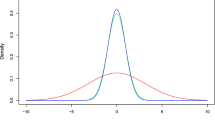Abstract
We consider the multiple change point problem in a general framework based on estimating equations. This extends classical sample mean-based methodology to include robust methods but also different types of changes such as changes in linear regression or changes in count data including Poisson autoregressive time series. In this framework, we derive a general theory proving consistency for the number of change points and rates of convergence for the estimators of the locations of the change points. More precisely, two different types of MOSUM (moving sum) statistics are considered: A MOSUM-Wald statistic based on differences of local estimators and a MOSUM-score statistic based on a global inspection parameter. The latter is usually computationally less involved in particular in nonlinear problems where no closed form of the estimator is known such that numerical methods are required. Finally, we evaluate the methodology by some simulations as well as using geophysical well-log data.



Similar content being viewed by others
Notes
Available at https://github.com/alan-turing-institute/rbocpdms/.
References
Adams, R. P., MacKay, D. J. (2007). Bayesian online changepoint detection. arXiv preprint arXiv:0710.3742.
Aggarwal, R., Inclan, C., Leal, R. (1999). Volatility in emerging stock markets. Journal of Financial and Quantitative Analysis, 34(1), 33–55.
Aue, A., Horváth, L. (2013). Structural breaks in time series. Journal of Time Series Analysis, 34(1), 1–16.
Baranowski, R., Chen, Y., Fryzlewicz, P. (2019). Narrowest-over-threshold detection of multiple change-points and change-point-like features. Journal of the Royal Statistical Society, Series B, 81, 649–672.
Bauer, P., Hackl, P. (1980). An extension of the mosum technique for quality control. Technometrics, 22(1), 1–7.
Braun, J. V., Braun, R. K., Müller, H.-G. (2000). Multiple changepoint fitting via quasilikelihood, with application to dna sequence segmentation. Biometrika, 87(2), 301–314.
Chen, J., Gupta, A. K. (2012). Parametric statistical change point analysis: With applications to genetics, medicine, and finance (2nd ed.). Boston: Springer Science & Business Media.
Cho, H., Kirch, C. (2021). Data segmentation algorithms: Univariate mean change and beyond. Econometrics and Statistics. https://doi.org/10.1016/j.ecosta.2021.10.008
Cho, H., Kirch, C. (2022). Two-stage data segmentation permitting multi-scale changepoints, heavy tails and dependence. Annals of the Institute of Statistical Mathematics, 74, 653–684.
Chu, C.-S.J., Hornik, K., Kaun, C.-M. (1995). Mosum tests for parameter constancy. Biometrika 82(3), 603–617.
Csörgö, M., Horváth, L. (1997). Limit theorems in change-point analysis. Hoboken: John Wiley & Sons Inc.
Eichinger, B., Kirch, C. (2018). A mosum procedure for the estimation of multiple random change points. Bernoulli, 24(1), 526–564.
Fearnhead, P. (2006). Exact and efficient bayesian inference for multiple changepoint problems. Statistics and Computing, 16(2), 203–213.
Fearnhead, P., Clifford, P. (2003). On-line inference for hidden markov models via particle filters. Journal of the Royal Statistical Society: Series B (Statistical Methodology), 65(4), 887–899.
Fearnhead, P., Rigaill, G. (2019). Changepoint detection in the presence of outliers. Journal of the American Statistical Association, 114(525), 169–183.
Fearnhead, P., Rigaill, G. (2020). Relating and comparing methods for detecting changes in mean. Stat, e291.
Fryzlewicz, P. (2014). Wild binary segmentation for multiple change-point detection. The Annals of Statistics, 42(6), 2243–2281.
Fryzlewicz, P. (2020). Detecting possibly frequent change-points: Wild Binary Segmentation 2 and steepest-drop model selection. Journal of the Korean Statistical Society, 49, 1–44.
Fryzlewicz, P. (2023). Narrowest significance pursuit: inference for multiple change-points in linear models. Journal of the American Statistical Association, 1–14.
He, X., Shao, Q.-M. (1996). A general bahadur representation of m-estimators and its application to linear regression with nonstochastic designs. The Annals of Statistics, 24(6), 2608–2630.
Horváth, L., Rice, G. (2014). Extensions of some classical methods in change point analysis. Test, 23(2), 219–255.
Hušková, M. (1990). Asymptotics for robust mosum. Commentationes Mathematicae Universitatis Carolinae, 31(2), 345–356.
Hušková, M. (2013). Robust change point analysis. Robustness and complex data structures (pp. 171–190). Berlin: Springer.
Hušková, M., Slabỳ, A. (2001). Permutation tests for multiple changes. Kybernetika, 37(5), 605–622.
Killick, R., Eckley, I. A., Ewans, K., Jonathan, P. (2010). Detection of changes in variance of oceanographic time-series using changepoint analysis. Ocean Engineering, 37, 1120–1126.
Killick, R., Fearnhead, P., Eckley, I. A. (2012). Optimal detection of change-points with a linear computational cost. Journal of the American Statistical Association, 107(500), 1590–1598.
Kirch, C., Kamgaing, J. T. (2012). Testing for parameter stability in nonlinear autoregressive models. Journal of Time Series Analysis, 33(3), 365–385.
Kirch, C., Kamgaing, J. T. (2015). On the use of estimating functions in monitoring time series for change points. Journal of Statistical Planning and Inference, 161, 25–49.
Kirch, C., Kamgaing, J. T. (2016). Detection of change points in discrete valued time series. In R. A. Davis, S. H. Holan, R. Lund, N. Ravishanker (Eds.), Handbook of discrete valued time series (pp. 219–244). Boca Raton: CRC Press.
Kirch, C., Klein, P. (2023). Moving sum data segmentation for stochastics processes based on invariance. Statistica Sinica, 33, 1–20. https://doi.org/10.5705/ss.202021.0048
Kirch, C., Weber, S. (2018). Modified sequential change point procedures based on estimating functions. Electronic Journal of Statistics, 12(1), 1579–1613.
Knoblauch, J., Jewson, J. E., Damoulas, T. (2018). Doubly robust bayesian inference for non-stationary streaming data with \(\beta\)-divergences. Advances in Neural Information Processing Systems, 31 .
Korkas, K. K., Fryzlewicz, P. (2017). Multiple change-point detection for non-stationary time series using wild binary segmentation. Statistica Sinica, 27(1), 287–311.
Li, M., Yu, Y. (2021). Adversarially robust change point detection. Advances in Neural Information Processing Systems, 34, 22955–22967.
Meier, A., Cho, H., Kirch, C. (2021). mosum: A package for moving sums in change point analysis. Journal of Statistical Software, 97, 1–42.
Messer, M. (2022). Bivariate change point detection: joint detection of changes in expectation and variance. Scandinavian Journal of Statistics, 49(2), 886–916.
Messer, M., Kirchner, M., Schiemann, J., Roeper, J., Neininger, R., Schneider, G. (2014). A multiple filter test for the detection of rate changes in renewal processes with varying variance. The Annals of Applied Statistics, 8(4), 2027–2067.
Mohammad-Djafari, A., Féron, O. (2006). Bayesian approach to change points detection in time series. International Journal of Imaging Systems and Technology, 16(5), 215–221.
Page, E. S. (1954). Continuous inspection schemes. Biometrika, 41, 100–115.
Reckrühm, K. (2019). Estimating multiple structural breaks in time series: A generalized mosum approach based on estimating functions (Doctoral dissertation, Otto-von-Guericke–Universität Magdeburg, Faculty of Mathematics). Retrieved from https://doi.org/10.25673/13832
Ruanaidh, J. J. O., Fitzgerald, W. J. (1996). Numerical bayesian methods applied to signal processing. New York: Springer Science & Business Media.
Ruggieri, E., Antonellis, M. (2016). An exact approach to bayesian sequential change point detection. Computational Statistics & Data Analysis, 97, 71–86.
Tartakovsky, A. (2019). Sequential change detection and hypothesis testing: General non-iid stochastic models and asymptotically optimal rules. New York: CRC Press.
Tartakovsky, A., Nikiforov, I., Basseville, M. (2014). Sequential analysis: Hypothesis testing and changepoint detection. New York: CRC Press.
Truong, C., Oudre, L., Vayatis, N. (2020). Selective review of offline change point detection methods. Signal Processing, 167, 107299.
Vostrikova, L. J. (1981). Detecting disorder in multidimensional random processes. Soviet Mathematics Doklady, 24, 55–59.
Wang, D., Yu, Y., Rinaldo, A. (2020). Univariate mean change point detection: Penalization, cusum and optimality. Electronic Journal of Statistics, 14(1), 1917–1961.
Wyse, J., Friel, N., Rue, H. (2011). Approximate simulation-free bayesian inference for multiple changepoint models with dependence within segments. Bayesian Analysis, 6(4), 501–528.
Yau, C. Y., Zhao, Z. (2016). Inference for multiple change points in time series via likelihood ratio scan statistics. Journal of the Royal Statistical Society: Series B (Statistical Methodology), 78(4), 895–916.
Acknowledgements
This work was supported by the Deutsche Forschungsgemeinschaft (DFG, German Research Foundation) - 314838170, GRK 2297 MathCoRe. Claudia Kirch would also like to thank the Isaac Newton Institute for Mathematical Sciences for support and hospitality during the program ’Statistical scalability’ when work on this paper was undertaken.
Author information
Authors and Affiliations
Corresponding author
Additional information
Publisher's Note
Springer Nature remains neutral with regard to jurisdictional claims in published maps and institutional affiliations.
Supplementary Information
The online version contains supplementary material available at https://doi.org/10.1007/s10463-023-00892-4. It contains additional simulations as well as the detailed proofs. Furthermore, R-code to generate Figs. 1, 2 and 3 is also provided.
About this article
Cite this article
Kirch, C., Reckruehm, K. Data segmentation for time series based on a general moving sum approach. Ann Inst Stat Math 76, 393–421 (2024). https://doi.org/10.1007/s10463-023-00892-4
Received:
Revised:
Accepted:
Published:
Issue Date:
DOI: https://doi.org/10.1007/s10463-023-00892-4




